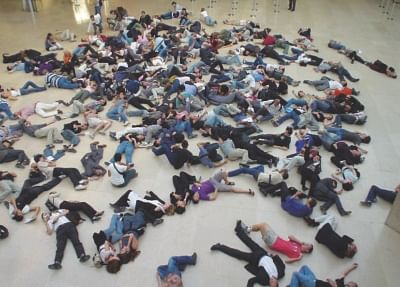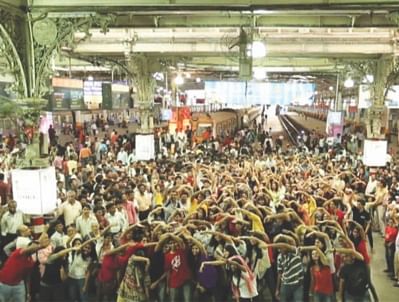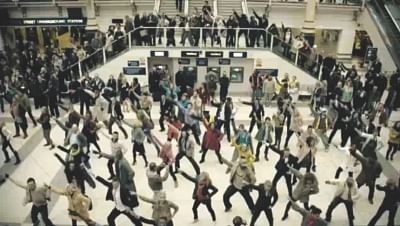| Home - Back Issues - The Team - Contact Us |
 |
| Volume 11 |Issue 43| November 02, 2012 | |
|
|
Trends THE BETTER MOB Soraya Auer
You're standing in a crowd at a train station or market place, going about your day with a certain level of urgency when suddenly music starts to play from hidden loudspeakers. You frown and look around to see other people express the same confusion. The next thing you know, ten people have started a dance routine to the first verse of the song. They are dressed perfectly normally, a couple in jeans and a t-shirt, another in a shalwar kameez, and one surprisingly dressed for a day in the office. Nothing about them suggests they know each other and yet you are witnessing them perform a synchronised routine together. As more people join them, you realise, you are watching a flash mob. This 'mob' is nothing sinister nor is it dangerous to be around. They're quite new to Asia and they are fast becoming a popular form of expression. Defined as a group of people who assemble suddenly in a place, perform an unusual and seemingly pointless act for a brief time and then disperse, flash mobs have become a medium for entertainment, satire, advertisement and even protest.
The first flash mobs were created in Manhattan, New York, in 2003 by Bill Wasik, senior editor of Harper's Magazine, as a social experiment designed to poke fun at hipsters and to highlight the cultural atmosphere for conformity. His first attempt to stage a flash mob in a shop failed because the shop was tipped off about the plan for a large number of people to gather. By letting people know of the plan at the last minute, Wasik was able to have the first successful flash on June 3, 2003. More than 130 people congregated around an expensive rug on the ninth floor of Macy's department store. The next flash mob saw 200 people flood the lobby and mezzanine of the Hyatt Hotel in synchronised applause for about 15 seconds. In an interview with The New York Times, Wasik said “the mobs starts as a kind of playful social experiment meant to encourage spontaneity and big gatherings to temporarily take over commercial and public areas simply to show that they could.” The concept which was once very original is now perhaps no longer as spontaneous as it was supposed to be as it has given unconformity a form of its own. But that is not to say the flash mob phenomenon has not developed and does not continue to surprise and entertain crowds of passersby. Plenty of videos of flash mobs across the world have gone viral over the years, some adverts or publicity stunts, some politically motivated and some just for the sake of having fun.
With more than 26 million hits on YouTube (access possible despite the ban) a popular video is the Sound of Music's “Do Re Mi” performed in Belgium's Central Station in Antwerp. Bewildered train users watched as more than 200 dancers accumulate and pull off a spectacular four minute show after only two rehearsals on March 23, 2009. A series of successful flash mobs in 2009 and 2010 were created for T-Mobile, a telecommunications company in the UK. They choreographed a mass dance routine in London's Liverpool Street Station, a singalong in Trafalgar Square and then finally a song and dance in London Heathrow's Terminal 5 International Arrivals. The last of these is a particularly feel-good video in which a track list of songs designed to resonate with travellers returning home were performed by singers supported by a human orchestra, making sounds of instruments from drums to violins. In the three minute video you witness a young couple being serenaded, a group of friends greeted with “The Boy's Are Back In Town” and an arriving Indian who takes an airport employee by surprise by shout-singing in his face “Oh-my-god-I-can't-believe-it-I've-never-been-this-far-away-from-home”. The advert, which has possibly gone down in e-history, was quite a feat to pull off, what with the sensitive nature of filming in an airport. More than 500 actors dressed as taxi drivers, cabin crew, baggage handlers and members of the public burst into song and dance during the course of the day-long shoot and sixteen hidden cameras captured the action and reactions. While flash mobs have become almost common in western countries, the phenomenon has spread to parts of Asia. India had its first flash mob performance in Mumbai's Chatrapati Shivaji Terminus one Sunday afternoon a few years ago, with similar ones having since been recreated across the large nation. Bangladesh saw its first flash mobs in Dhaka this September. One was part of the inauguration programme for the Urban Youth Festival at Goethe Institut and the second was outside Radio ABC's offices in Karwan Bazar, Dhaka. Around fifty young people gathered and performed the catchy and hugely popular (but annoying) South Korean hit “Gangnam Style”, in protest to the YouTube ban and in support of Bangladesh Cricket team in this year's T20 World Cup. Spontaneous but with a point, flash mobs are an unconventional approach to conveying otherwise conventional issues and ideas. They are even becoming more out of the box, as seen in the lead up to London's Olympics where people gathered and posed in starting positions of various sports on shopping streets. In a country like Bangladesh, the word 'mob' has a negative connotation but future flash mobs have the potential to change that. Interestingly also, the way flash mobs are eternalised online gives Bangladesh its chance to become just that more digital.
|
||||||||||||||||
Copyright
(R) thedailystar.net 2012 |



